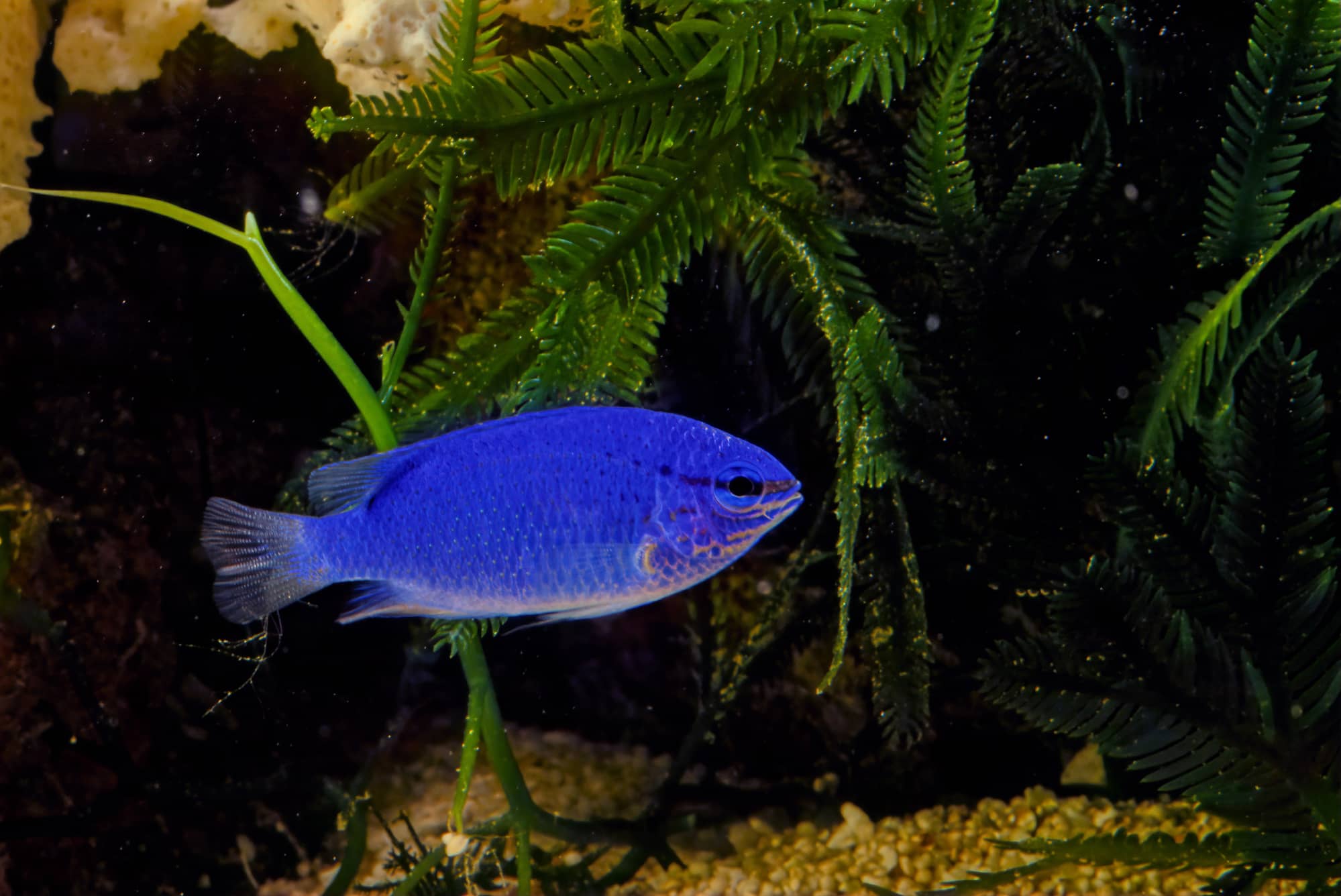If you’re a newbie to the marine aquarium hobby, you need to read this guide to the Blue Damselfish! This beautiful species of fish is among the most popular saltwater fish in the damselfish family, being both stunning to look at and easy to care for.
Keep reading to find out everything you need to know about Blue Damselfish and its care requirements.
Overview
The Blue Damselfish is a hardy, inexpensive tropical species of damselfish — an excellent choice for beginner fish enthusiasts and advanced marine aquarists alike.
On the downside, damselfish, especially large males, have a reputation for aggressive behavior. In particular, damselfish will regularly pick on a peaceful tank mate in their space, such as a blenny, goby, firefish, or cardinalfish.
That said, Blue Damsel Fish are coral reef safe and don’t bother with inverts or corals.
A Fish of Many Names
The Blue Damselfish is known by many other common names, including:
- Blue Devil
- Sapphire Devil
- Sky-blue Damsel
- Blue Demoiselle
- Orangetail Damselfish
- Orangetail Blue Damselfish
- Cornflower Sergeant Major
- Red Tail Australian Damselfish
- Devilfish
- Hedley’s Damselfish
It’s not surprising, therefore, that the species is sometimes confused with another neon blue damselfish that belongs to the same Chrysiptera genus, the Fiji Blue Devil damselfish. These fish look similar to the Blue Damsel, but they are a much more aggressive fish species.
Origins
The Blue Damselfish, Chrysiptera cyanea, was first described in 1825 by Quoy and Gaimard.
These common fish are found widely across the Indo-Pacific Ocean, ranging from the eastern edges of the Indian Ocean, New Guinea, Western Australia off the northern area of the Great Barrier Reef, around the Caroline Islands, Solomon, Mariana, Philippines, Indonesia, Ryukyu Islands, and Taiwan. Populations are also reported from New Caledonia, Vanuatu, Yap, and Palau in Micronesia.
Chrysiptera genus
The Blue Damselfish belongs to the subfamily Pomacentrinae in the Chrysiptera genus of the Pomacentridae family of tropical fish, including Anemonefish and Damselfish. There are currently some 34 species in the Chrysiptera genus.
Although some Chrysiptera are found at deep reef zones, most inhabit the shallow water of bays, lagoons, and coastal reefs, gravitating to corals or hovering over the substrate. They are omnivorous, feeding on a varied diet of tiny benthic crustaceans, algae, and plankton.
Many of the most brightly colored and smallest damselfish belong to this genus. The average adult size of these beautiful little tropical fish is around 2.8 inches in length or slightly more. Although fish in this genus are reputedly aggressive, they are less belligerent than many of the Chrysiptera, making them suitable for life in a community tank.
Lifespan
Blue Damselfish only live for a few years in the wild environment, where they can fall victim to predators. However, they can live for up to 15 years when kept in the safety of a well-maintained saltwater tank.

Appearance
Blue Damselfish are deep-bodied, elongated fish that grow to reach maximum sizes of around 3.4 inches in length.
The fish are a bright blue color with a dark stripe that extends through the eye and across the snout. As they mature, female fish develop a black spot at the base of the dorsal fin and transparent fins.
It’s relatively easy to distinguish male Blue Damselfish from females, as the species is dichromatic. There are two distinct color variants, depending on their location.
Blue Damselfish from Japan and the Philippines are rich blue, with males sporting dark borders on their fins. The degree of coloration on the male’s tail varies, depending on their spawning prowess. Fish that attract the most females tend to develop more vibrantly colored tails than less desirable males.
Blue Damsels from the remainder of the range are also referred to as Orangetail Damselfish. As the male fish mature, they develop beautiful orange-yellow tail coloration, and some will also have a yellow-orange nose.
Diet and Nutritional Requirements
Blue Damselfish are omnivorous, feeding on algae, tiny crustaceans, and fish eggs. So, in captivity, you need to provide the fish with a mixture of food types, including meaty protein, vegetables, and flake foods. Vitamin-enriched brine shrimp, Mysis shrimp, cyclops, frozen seafood, and herbivore flakes make a good diet for Blue Damselfish. Including color-enhancing flake foods in the diet helps to keep the fish looking vibrant and beautiful.
How much to feed Blue Damselfish
We recommend that you feed the fish several times every day, offering small amounts the fish can clear within a couple of minutes. This strategy works to dissipate any possible aggressive behaviors within the community.
To prevent digestive issues, you need to wet any dry pellet food before feeding so that air doesn’t enter the fishes’ digestive tract.
What’s the ideal tank setup for Blue Damselfish?
Blue Damselfish are hardy and easy to keep, provided that you keep the entire tank well-maintained.
Tank size
You really can’t get away with a fish tank size smaller than a 30-gallon tank when keeping Blue Damselfish, whether in a pair or just keeping a single fish. We recommend a larger tank if you can afford it. Plus, with a tank that small, you’ll also need to perform frequent water changes — preferably bi-weekly to replace trace elements in the water that corals and other fish have used up.
In fish-only setups, the following water change regimen is necessary:
- Tank size up to 40 gallons: 10% bi-weekly water changes or 20% monthly
- Tanks up to 90 gallons: 15% bi-weekly
- Tanks over 100 gallons: 10% bi-weekly, 20% monthly, depending on the bioload
In reef tanks, the following water change routine is advised:
- Tanks up to 40 gallons: 15% bi-weekly water changes or 20% monthly
- Tanks up to 90 gallons: 20 to 30% monthly, depending on the bioload
- Tanks over 100 gallons: 20 to 30% every six weeks, depending on the bioload
Tank decoration
The best way to avoid confrontations between large male Blue Damselfish and other tank mates is to provide lots of hiding places in your tank decoration. Rockwork or corals offer lots of spots where the fish can take shelter.
You can use any lighting and substrate in your aquarium unless you have corals, in which case you must consider their needs.
Water parameters
The water conditions preferred by the Blue Damselfish are similar to those of clownfish. Water temperature needs to be between 72 and 84F, and water pH in the range of 8.1 to 8.4.
Tank Mates
Choosing tank mates that are a good fit for these aggressive fishes is complex, and the Blue Damsel is not suitable for a peaceful community tank. As with all damselfish, the Blue Devil Damselfish are inclined to be territorial and belligerent as they mature. Females and young fish are more peaceable. Also, pairs of these fish are more aggressive than single specimens.
That said, you can keep Blue Damselfish in small groups, provided that the ratio of males to females is correct. So, you could own one male damsel with a harem of females or a few juveniles in a medium to a large tank that has plenty of hiding places.
Blue Damselfish pairs best with semi-aggressive, dominant fish larger than the damsels, such as large angelfish, triggerfish, dottybacks, and puffers in a community setting.
You should avoid keeping Blue Devils with small juvenile butterflyfish and angelfish, as well as peaceful species, including firefish, blennies, gobies, and cardinalfish. Also, avoid predatory fish large enough to swallow a Blue Devil.
Reef tanks
Blue Damselfish generally do very well in a reef aquarium since they don’t pose a threat to corals and don’t threaten inverts.
Breeding Blue Damselfish
All damselfish species follow the general breeding behavior of clownfish.
To breed damsels, you need to provide the fish with the proper tank conditions and a large aquarium free from predators that will eat the fishes’ eggs. Species to avoid include serpent stars, crabs, brittle stars, and wrasses. The water temperature in your breeding tank should be 79° to 83°F.
Spawning
Blue Devil Damselfish spawn very readily in an aquarium setting. Each male fish establishes a territory close to a nesting site with a half-clam shell or some rubble close to the entrance.
Female damselfish then inspect all the males in the area to select the fittest and strongest for breeding, including any she has previously spawned with. Once she chooses, the female floats upward and flashes a light ring around her eye. The male responds by commencing a courting performance with which he hopes to impress the female. But that’s not it! The female is far too picky to settle on a mate until she’s inspected every male’s nest in the vicinity, sometimes traveling up to 325 feet between nesting sites.
Having given due consideration to her decision, the following day, the female spawns with the best male. Sometimes, there can be up to four females queuing up outside a male’s nest if he is particularly impressive!
Once all the eggs have been deposited, the male stands guard over them, protecting his clutch of eggs until they hatch, usually within four days. The offspring remain in the larval stage for between ten and 50 days.
Health and Disease
Once the Blue Damselfish is acclimated to the aquarium, it’s a pretty hardy fish that doesn’t generally get sick. Typically, the leading cause of sickness and mortality of these beautiful fish of the Chrysiptera genus is the stress of shipping and transportation.
That said, sometimes sudden deaths do occur for no apparent reason. One day, the fish appears to be completely healthy; the owner finds their Blue Damsel dead in the tank the next day.
That said, there are a few common diseases of saltwater fish that Blue Damselfish can be susceptible to, especially if they are stressed or injured. For that reason, it’s sensible to quarantine your fish for at least two weeks before introducing them to your main display tank.
Diseases that can affect Blue Damsels include:
- White Spot Disease, Marine Ich or Cryptocaryon irritans
- Velvet Disease or Oodinium ocellatum
- Uronema disease
Aquatic parasites cause all these diseases.
- Marine Ich is easily treatable if you catch it in time by dosing the tank with an over-the-counter Ich treatment.
- Marine Velvet is caused by a parasitic skin flagellate that mainly attacks the fish’s gills.
- Uronema is usually a secondary infection and is the most severe disease of the three, often proving deadly quickly. This condition usually appears when the hobbyist reduces the salinity in the tank to treat other diseases but fails to lower the levels sufficiently. The parasite needs a brackish salinity of around 1.013 to 1.020 to thrive.
Availability
The Blue Devil Damselfish can be purchased from online suppliers and marine fish stores and are relatively inexpensive, retailing at around $15 per fish.
In Summary
The Blue Damselfish is a beautiful and popular saltwater aquarium fish that can make an excellent addition to a reef or fish-only marine aquarium. These fish are hardy and easy to care for once acclimated, making them a good choice for a beginner.
These stunning creatures are small but feisty, so ideally, you want to keep a pair or a single specimen unless you have a huge tank. Small groups of Blue Damselfish can live together, but you need to keep one male to a group of females and provide plenty of hiding places so that the male can establish a territory.
Do you keep Blue Damselfish? Tell us in the comments box below if you managed to breed them.


























